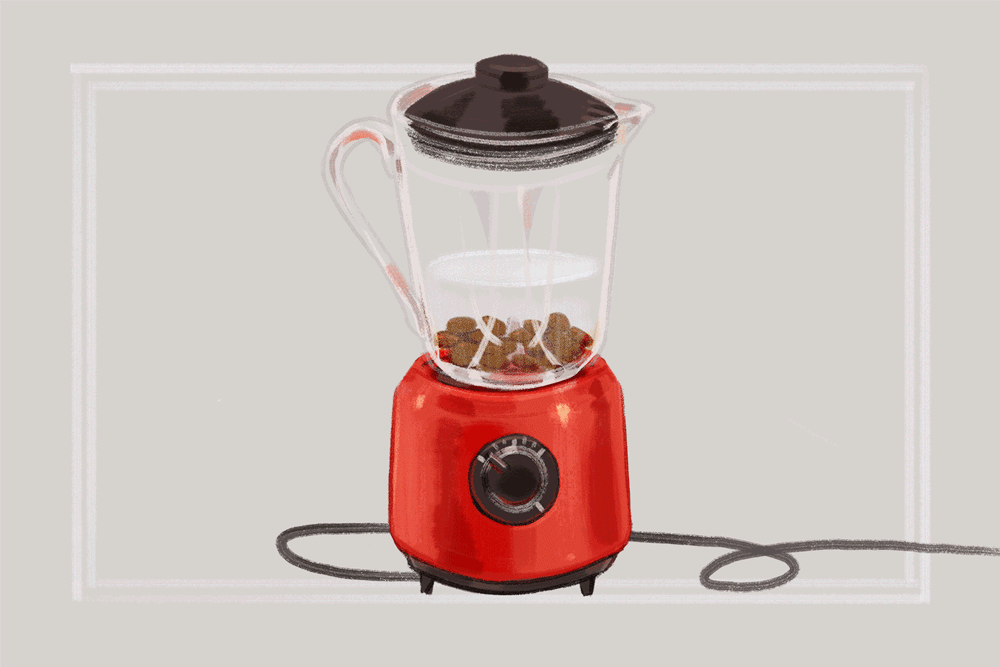Avoid the grocery store by making your own pantry staples at home

- Share via
Our current reality of social distancing means that if you’re not on the frontlines of responding to the pandemic (if you are, thank you!) you are about to have a lot of time on your hands.
What better time than now to get in touch with your agrarian roots by learning to make a few pantry staples yourself? It’s a great way to use up all the free time you’ve got now, channeling it toward food you can eat via a new skill and not into falling down an anxiety k-hole of news clips and virus memes.

Almond milk:
Though you might not be vegan or ever thought you’d like almond milk, now is a great time to test out both of those stances. Nut milk is easy to make and only requires almonds (or cashews or peanuts) and water.
Start with a ratio of 1 ½ cups raw almonds to 4 cups boiling water. The almonds you use would ideally be whole and blanched (i.e. skin removed), but any almonds (slivers, slices, pre-chopped) will work if that’s all you can find (cashews and peanuts work especially well because there’s no skin to remove in their packaged forms).
Place the nuts in the canister of a blender and cover them with the water. Let the water cool completely to room temperature, which should take between 30 to 60 minutes depending on the temperature of your kitchen. Place the canister on the blender base and blend on high speed until as smooth as possible, at least 1 to 2 minutes.
Next, if you have a nut milk bag, use it, but assuming you don’t a fine mesh sieve works just as well. As a last resort: take one-ply of a paper towel square, soak it in water, wring out the excess, then unfurl the sheet and drape it over a bowl of large mesh sieve. Whichever method you choose, pour small amounts of the puree into it and allow the liquid to drain into a bowl below, using a spoon to press the solids against the sieve repeatedly until they’re dry. If you’re using a nut milk bag or paper towel sheet, gently massage the solids through the bag/towel until all the liquid has been drained from them. Repeat until you’ve processed all the nut milk. (Pro tip: save the leftover nut pulp and add it to your granola, below.)
Transfer the nut milk to a storage container and stir in a little sugar and a pinch of salt, if you’d like. Covered and refrigerated, the milk will last for up to 3 days. Make sure to shake it up again before each use as it will separate.

Granola:
This can be as simple as plain toasted oats or you can go all-in by using up all the leftover bits of nuts and grains you have in your pantry. The point here is to make a big batch of cereal to keep around for breakfasts and snacking that will keep in your pantry for weeks on end.
The basic recipe is 4 cups of dry grains plus 1 cup nuts/seeds plus ¾ cup liquids.
Let’s start with the dry grains. The most obvious candidate here is rolled oats and should, ideally, comprise at least half of the 4 cups. But if you have other cooked grains in your fridge, like rice, wheat berries, farro, quinoa, etc., those can work too, you’ll just want to spread them out on a parchment paper-lined baking sheet and dehydrate them in a 200-degree oven, stirring them every 10 minutes or so, until they’re dry to the touch.
As for the nuts/seeds, this can be any combination of nuts (almonds, cashews, peanuts, walnuts, pecans, hazelnuts) or seeds (pumpkin, flax, sunflower, sesame) you like. Got an old container of deluxe mixed party nuts? Use those; just give them a rough chop first. Remember that leftover pulp you saved from making your own nut milk (above)? Treat it like the cooked grains, above, and dehydrate it before adding it to the mix here.
Then you can add in your favorite sweetener and fat. I prefer a mixture of ¼ cup fat to ½ cup sweetener, but adjust to your taste. For fat, use your favorite oil (olive, coconut, plain vegetable, whatever you normally cook with) or melted butter or ghee. For sweeteners, I prefer maple syrup, but coconut sugar, light/dark brown sugar, agave nectar and plain granulated sugar all work well too.
Once you’ve got all your ingredients accounted for, toss them in a big bowl together and mix and massage everything with your (washed!) hands until all the grains and seeds are evenly coated. If you want to add spices, now is the time: sprinkle some cinnamon, ground ginger, cloves, allspice or cardamon over the whole mix. Add in a splash of vanilla extract, if you like, and definitely add in a hefty pinch of salt.
Toss it again then spread it out on a standard 18-by-13-inch rimmed baking sheet. Place it in a 325 degree oven and bake, stirring it and spreading it out again every 5 minutes, until lightly toasted and golden brown, about 50 minutes. If you want a slightly more moist granola, pull it at 40 minutes; if you like really dark and toasted, aim for 1 hour.
Once it’s done, let it cool completely, then stir in any type of dried fruits, if that’s your jam. Raisins, dried cranberries, chopped dried apricots or figs, these are all great additions. Pack it up in airtight storage containers and use it, obviously, for breakfast, but also stir some into loaf cakes for crunch, as a topping for vanilla or chocolate pudding, or as a crunchy topping for a bowl of fruit, if you’re being good and getting in your dose of vitamin C each day. Or just stress eat it by the handful. Now is not the time to judge ourselves.

Pasta:
Sure, dried pasta is a boil-and-sauce-it wonder on busy weeknights. But when you’ve got more time than you know what to do with, skip the pasta aisle and grab a couple bags of good ol’ all-purpose flour to make your own. Despite what you might think, you don’t need special Italian flour to make good pasta, nor do you need eggs. Just flour and water and your imagination.
Start by placing 3 cups of flour in a bowl then making a well in the center with your fingers. Next, pour in ½ cup water to start. If you have lots of oil on hand, add in ¼ cup now to add a bit of softness to the dough; otherwise, add in another ¼ cup water. Sprinkle the liquid with a hefty pinch of salt, then, using your fingers, gently stir the liquid, bringing in a little of the flour as you stir. Go slow and stir continuously until the dough begins to form.
Eventually you can modulate to a half-stirring/half-kneading motion until the dough becomes either too dry or too stiff to work with, then add another 2 tablespoons water. Keep mixing and stop again if it’s too dry and add another 1 tablespoon water. You want to keep mixing and adding water, little by little, in this fashion until there are no more patches of dry flour left and the dough feels just moist and holds together in a ball that you can easily pick up.
Finally, take the dough ball out of the bowl and place it on your clean counter and knead it until it’s pretty stiff and doesn’t bounce back when you press your finger tip in it, about 8 to 10 minutes. Put the dough ball back in the bowl you started with and cover it with a sheet of plastic wrap or a damp kitchen towel. Let it rest at room temperature for an hour or wrap the dough ball completely in plastic wrap and refrigerate it for up to 2 days.
When you’re ready to roll your pasta, you’ve got two options: If you’re part of the 1% that owns a pasta rolling machine (raises hand), you’re in luck and this will be easy for you (you also, like, probably already know how to make fresh pasta). But for everyone else, just remember that you have a lot of time on your hands so get ready to use it.
Cut the dough ball into four pieces and keep three of the pieces wrapped in plastic to keep them from drying out. Place the piece you’re going to use on a lightly floured work surface and grab a rolling pin, wine bottle, or, hell, a nonstick cooking spray can; anything cylindrical that you can use to roll with. Lightly flour the rolling implement and start rolling and flattening the dough ball in every direction, using whatever creative maneuvers you want. Unlike pie dough, which is finicky and must be worked with gently and quickly to avoid disaster, pasta dough is very forgiving and just needs to be flattened, period. Take your time here and enjoy the process, using little pinches of flour, as needed, to keep the dough from sticking to the surface or your rolling cylinder.
Once it’s all flattened to about 1/16-inch thick (no ruler? Just get the dough as flat as the thickness of your headphone cord), here’s where you can get creative. You can cut and rip the pasta in random ways (look up the infinite shapes you can make, and tutorials on how to shape them, on YouTube if you want, that can occupy 15 minutes to a week of your time, the videos with the old Italian grandmas are my favorites), but the conventional noodle strips and strands are the easiest and most useful. Start by liberally dusting your amorphous sheet of pasta then roll it up like one big crazy-looking cinnamon roll. Using a knife, cut ½- to ¼-inch thick slices off the roll until all the pasta is cut. Unfurl all the slices, revealing the long noodles, then toss with more flour to keep everything from sticking together. Transfer the cut pasta to a parchment paper-lined baking sheet to dry out. Repeat rolling and cutting the rest of your pasta.
Once it’s all cut and on the parchment paper sheet, you can leave it out at room temperature overnight to dry it out slowly. If you have the fridge space, you can refrigerate the pasta until you’re ready to cook it. Either way, use it within a couple days so you can make more.

Flour tortillas:
Sure, you could learn to bake bread, but that requires yeast and that may or may not be on your list of “absolute must-haves” right now. So, instead, make flour tortillas; I promise your PB&J will taste just as delicious on them.
Start by making the pasta dough method above, with 3 cups flour, ½ cup oil and 1 cup boiling water. Once the dough comes together, add more water, if needed, then knead the dough until it’s smooth. Wrap the dough in plastic and let rest for 1 hour to relax it. Pinch off walnut-sized balls of dough then flatten them with whatever rolling implement you have or a tortilla press if you have one and stack them off to the side, separating each tortilla by a sheet of parchment or wax paper to keep them from sticking to each other.
Heat a large skillet over medium-high heat until it just begins to smoke. Add a tortilla and cook, checking the bottom so that it doesn’t burn. Cook it for about 1 minute, until it’s golden brown and lightly puffed. Flip the tortilla and continue cooking until it looks the same on the opposite side. Transfer the cooked tortilla to a plate lined with a kitchen towel and cover it with another towel to keep the tortilla warm. Repeat with the remaining tortillas until they’re all cooked through.
Once they’re all cooked and stacked, you can eat the tortillas right away or let them cool completely, wrap them in plastic, and refrigerate or freeze them for up to a couple weeks. To reheat, warm each one in a skillet again, but this time over medium heat, flipping halfway through until they’re hot and pliable on both sides.
More to Read
Eat your way across L.A.
Get our weekly Tasting Notes newsletter for reviews, news and more.
You may occasionally receive promotional content from the Los Angeles Times.











